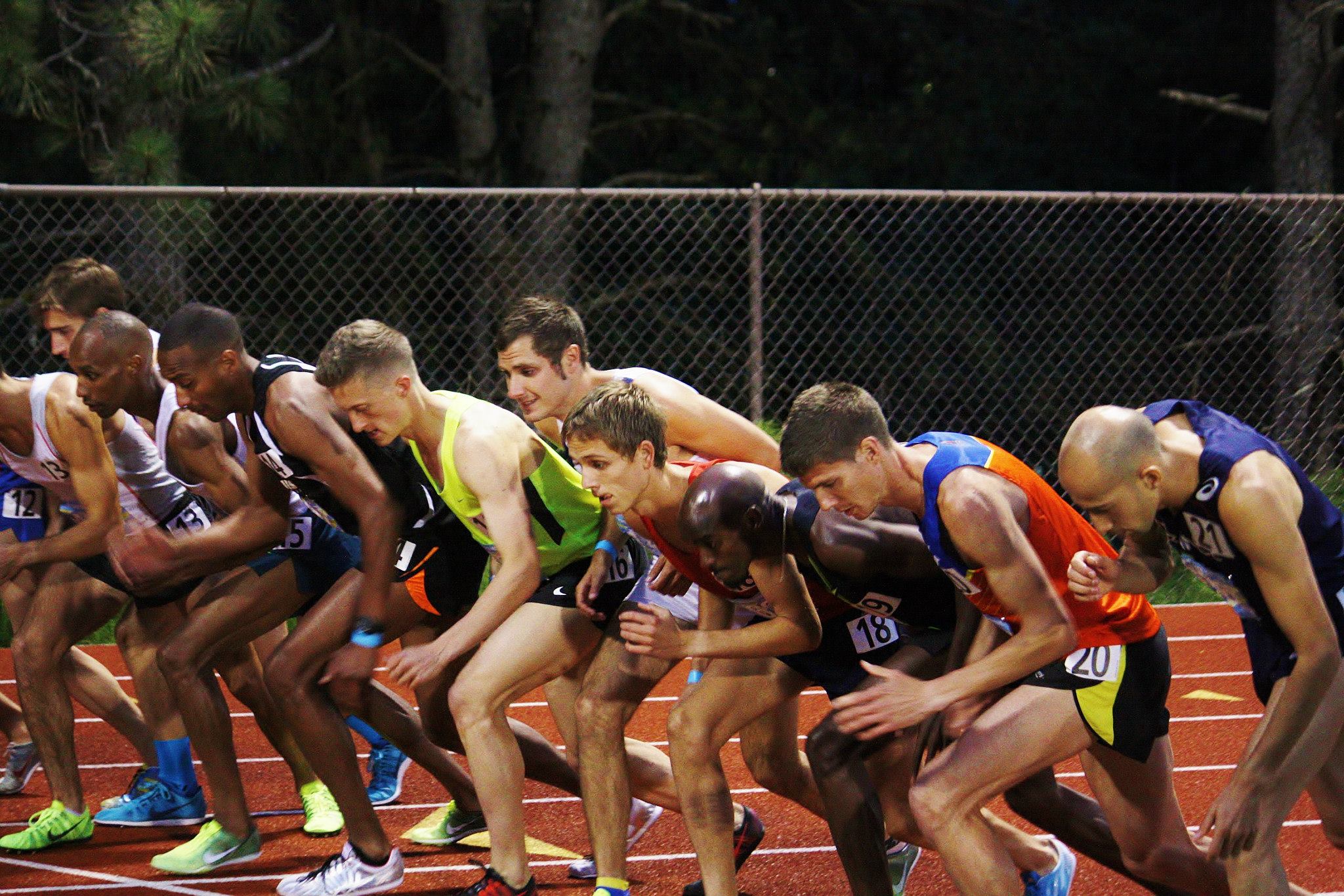News
Is Barry’s Good for Marathon Training? Find Out Here!
Published
5 months agoon
By
Anderson
If you’re training for a marathon, you might be considering different ways to boost your stamina, strength, and endurance. One popular workout program gaining attention among runners is Barry’s Bootcamp. But is Barry’s good for marathon training? In this article, we’ll dive deep into Barry’s Bootcamp, its benefits, limitations, and how it fits into a marathon training plan. Whether you’re a seasoned marathoner or a beginner, keep reading to find out everything you need to know!
What Is Barry’s Bootcamp?
Barry’s Bootcamp is a high-intensity interval training (HIIT) program designed to combine strength training with cardio in a fast-paced, high-energy environment. Founded in 1998, Barry’s Bootcamp has grown into a global fitness phenomenon. Classes typically involve treadmill sprints, strength exercises using weights or resistance bands, and a focus on full-body fitness.
Each session is divided into two main parts: half of the time is spent running or sprinting on a treadmill, while the other half is dedicated to floor work for strength and conditioning. Barry’s is known for its upbeat music, motivating trainers, and challenging workouts that push participants to their limits.
But how does this relate to marathon training? Let’s explore.
Does Barry’s Help Marathon Runners Build Stamina?
Stamina is one of the most crucial aspects of marathon training. Without it, you won’t be able to sustain the physical and mental effort required to complete 26.2 miles. Barry’s Bootcamp, with its treadmill sprints and high-intensity intervals, can certainly help improve cardiovascular fitness.
The interval training approach used in Barry’s mimics the demands of marathon running to an extent. For example, alternating between high-intensity treadmill sprints and active recovery can simulate the ebb and flow of energy during a race. This can help runners build the stamina needed to maintain their pace throughout a marathon.
However, while Barry’s can help with stamina, it’s not a one-size-fits-all solution. Marathon training requires specific adaptations that Barry’s alone may not provide.
Benefits of Barry’s Bootcamp for Marathon Training
Barry’s Bootcamp offers several benefits that can complement a marathon training plan. Let’s break these down:
Builds Strength to Prevent Injuries
Marathon runners are prone to overuse injuries, especially in the legs, knees, and hips. Barry’s includes strength training exercises that target muscle groups often neglected by runners, such as the core, glutes, and upper body. By strengthening these areas, runners can improve their running form and reduce the risk of injury.
For example, exercises like squats, lunges, and deadlifts can help build stronger legs and glutes, which are essential for maintaining stability and power during long-distance runs. A stronger body is less likely to break down under the repetitive stress of marathon training.
Boosts Cardio Endurance with Interval Training
The treadmill intervals at Barry’s are excellent for building cardiovascular endurance. Running sprints at varying speeds and inclines forces your heart and lungs to work harder, improving their efficiency. This can translate to better aerobic capacity and a stronger ability to sustain a steady pace during your marathon.
Additionally, the short bursts of intense effort followed by active recovery simulate the physical demands of race day, where you may have to adjust your speed or effort depending on the course or your energy levels.
Adds Variety to Your Training Plan
Marathon training can sometimes feel monotonous, especially when you’re logging long miles week after week. Adding Barry’s Bootcamp to your routine introduces variety and keeps things fresh. The combination of treadmill work, strength training, and an energetic group environment can help prevent burnout and keep you motivated.
What Barry’s Lacks for Marathon Training
While Barry’s Bootcamp offers many benefits, it’s not a complete solution for marathon training. Here are a few areas where it falls short:
- Long-Distance Runs: Marathon training requires long runs to build endurance and mental toughness. Barry’s treadmill sprints are great for short bursts of intensity but don’t replicate the sustained effort needed for long-distance running.
- Specificity: Marathon training is about preparing your body for the specific demands of running 26.2 miles. Barry’s focuses on general fitness rather than the specialized endurance training required for a marathon.
- Recovery Emphasis: Marathon training also requires careful attention to recovery, including proper rest days and low-intensity workouts. Barry’s high-intensity sessions can be taxing, and overdoing it can lead to fatigue or injury.
Should You Use Barry’s as a Marathon Runner?
So, is Barry’s good for marathon training? The answer depends on your goals and how you incorporate it into your plan. Barry’s can be a fantastic supplementary workout, helping you build strength, improve cardio endurance, and add variety to your routine. However, it should not replace key elements of marathon training, such as long runs, tempo runs, and recovery days.
If you’re a beginner, you may want to start with a more traditional marathon training program and use Barry’s as an occasional cross-training option. Advanced runners, on the other hand, might benefit from integrating Barry’s into their training to target specific weaknesses or add intensity.
How to Combine Barry’s with Marathon Training
To get the most out of Barry’s Bootcamp while preparing for a marathon, it’s important to strike the right balance. Here’s how:

Plan Your Rest Days
Barry’s is a high-intensity workout, so it’s crucial to schedule adequate rest days. Avoid doing Barry’s on the same day as a long run or the day before a hard workout. Instead, use it on days when you need a challenging but shorter session.
Alternate Long Runs with Barry’s Sessions
Your long runs are the cornerstone of marathon training, so don’t let Barry’s interfere with them. For example, you might do a long run on Sunday and a Barry’s session on Wednesday to allow for proper recovery.
Focus on Recovery and Nutrition
Barry’s can be physically demanding, so recovery is key. Make sure you’re getting enough sleep, staying hydrated, and eating a balanced diet to fuel your workouts. Foam rolling, stretching, and yoga can also help prevent muscle soreness and improve flexibility.
Thoughts: Is Barry’s Good for Marathon Training?
Barry’s Bootcamp can be a valuable tool for marathon runners, but it’s not a standalone solution. Its combination of strength training and interval cardio can enhance your overall fitness, reduce injury risk, and keep your training exciting. However, marathon-specific workouts like long runs and tempo runs remain essential for preparing your body and mind for race day.
The Bottom Line
Barry’s Bootcamp is an excellent addition to a marathon training plan, especially if you’re looking to improve your strength, endurance, and overall fitness. However, it should be used as a complement to, not a replacement for, traditional marathon training. By balancing Barry’s with long runs, recovery, and proper nutrition, you can enjoy the best of both worlds and set yourself up for marathon success.
Whether you’re chasing a personal best or simply aiming to cross the finish line, a well-rounded approach that incorporates both Barry’s and marathon-specific training can help you achieve your goals. So, lace up your running shoes, book a Barry’s class, and get ready to crush your next marathon!
You may like
News
Who Is Jordan Boone? Learn About This Inspiring Person from the USA
Published
9 hours agoon
June 26, 2025By
Anderson
Jordan Boone is becoming a name that more and more people are searching for across the internet. Whether it’s curiosity about who he is, where he comes from, or what he stands for, there’s no doubt that Jordan Boone is capturing attention. This article explores everything you need to know about this inspiring figure from the United States. From his roots to his work in the community, and his dreams, you’ll get a full picture of who Jordan Boone really is. Let’s dive in.
Who Is Jordan Boone?
Jordan Boone is a passionate and driven individual from the United States, known for his strong presence in community work and leadership. Though he may not be a celebrity in the traditional sense, Boone is becoming increasingly recognized for his contributions in various fields—whether it’s public speaking, charity, or helping people improve their lives. He stands out because of his unique ability to connect with others and make a difference without seeking the spotlight.
He is someone who focuses on real change. While some chase fame, Jordan Boone channels his energy into doing meaningful work that leaves a long-lasting impact. This is why more people are typing “Jordan Boone” into search engines. They want to learn more about someone who seems to inspire just by being himself.
Where Is Jordan Boone From?
Jordan Boone is proudly from the United States. While exact details about his hometown remain private, sources suggest he grew up in a mid-sized city where community ties are strong, and values like hard work and kindness are celebrated. His American roots play a big role in shaping who he is. He often speaks about how growing up in the U.S. taught him about unity, opportunity, and the power of never giving up.
Many believe that his small-town upbringing is one of the main reasons he’s so grounded. He learned early on that helping others isn’t just a good thing to do—it’s the right thing to do. His background continues to influence the work he does today, making him a relatable figure to many people across the country.
What Does Jordan Boone Do?
Jordan Boone wears many hats. He is deeply involved in projects that help others, whether that’s through education, public events, or volunteering. Boone’s work is built around leadership, compassion, and service. He believes in using his time and skills to give back to his community and inspire the next generation.
While he doesn’t always work in the public eye, people know him as a figure who takes action when it matters. He often collaborates with local organizations to help underprivileged groups and support causes like youth education, mental health awareness, and financial literacy. His work reflects a deep sense of responsibility, not only toward his own goals but also toward helping others reach theirs.
Is He in Sports?
Jordan Boone has been involved in sports, especially during his youth. Though he may not be a professional athlete, he understands the importance of physical activity and teamwork. Sports helped him build discipline, leadership, and resilience—skills he continues to use in his personal and professional life. He often supports local youth sports initiatives and encourages kids to stay active and committed to their dreams, whether that’s in athletics or beyond.
Is He a Public Speaker?
Yes, Jordan Boone is a well-respected public speaker. He uses his voice to motivate, educate, and connect with people from all walks of life. Whether he’s speaking at a school, church, community center, or conference, his goal is always the same: to leave people feeling empowered. His talks usually focus on hope, perseverance, and making positive choices.
People who have attended his speeches often say they walk away feeling more inspired and confident. He doesn’t just talk at people—he speaks with them, sharing stories that feel real and honest. He also speaks on leadership, offering advice to young adults and professionals trying to find their way in the world.
Does He Help in the Community?
Absolutely. Community work is at the heart of what Jordan Boone does. He volunteers his time with local charities, mentors young people, and helps organize events that bring people together. Whether it’s feeding the homeless, organizing school supplies for kids, or just listening to someone who needs support, Boone always shows up.
He believes that real change starts locally. By working closely with his community, he ensures that his impact is personal and meaningful. Many people look up to him because of this hands-on approach. He’s not someone who just talks about change—he makes it happen.
Why Are People Searching for Jordan Boone?
People are searching for Jordan Boone because he represents something rare in today’s fast-paced world: authenticity. He’s not trying to be famous for the sake of being famous. Instead, he’s making a name for himself by being genuine, kind, and driven. In a time when negativity often dominates the headlines, Jordan Boone stands out as a positive force.
The rise in search volume for “Jordan Boone” is likely due to his recent appearances at community events, motivational talks, and social media presence. More people are discovering his work and wanting to learn more about who he is. They’re looking for someone they can relate to, someone who gives hope—and Boone fits that perfectly.
What Is Jordan Boone Known For?
Jordan Boone is known for his dedication to helping others. He may not be a household name yet, but he’s building a strong reputation in communities across the country. People know him for his speeches, his mentoring work, and his volunteer efforts. He’s not afraid to get involved, and he always brings a positive attitude wherever he goes.
He’s also recognized for his focus on youth development and mental health advocacy. Boone believes that everyone, no matter their background, deserves a chance to succeed. His work reflects this belief, and he consistently finds ways to uplift others.
Is Jordan Boone on Social Media?
Yes, Jordan Boone is active on social media, where he shares messages of encouragement and updates about his community work. His social media platforms—like Instagram, Twitter (now called X), and Facebook—are filled with uplifting posts that reflect his mission of helping others live better lives.
You won’t find flashy content or drama on his pages. Instead, you’ll find real stories, community highlights, and motivational thoughts. He uses social media as a tool for good, and many people appreciate the honesty and positivity he brings to their feeds.
What Do People Say Online?
Most online comments about Jordan Boone are overwhelmingly positive. People admire his kindness, his commitment to his community, and his ability to stay grounded even as he gains recognition. Many call him a role model. Others say that hearing him speak changed their lives.
His online followers often share stories about how Jordan inspired them to make better choices or pursue their goals. They trust him because he’s consistent in his message and his actions. Unlike many public figures, he hasn’t let success change who he is.
Does He Share His Story?
Yes, Jordan Boone openly shares his personal journey—both the good and the tough parts. He believes that telling the truth about your struggles is a way to connect and help others. His story includes lessons about hard work, family values, and personal growth. By being transparent, he encourages others to do the same.
He talks about how he didn’t have all the answers growing up but learned through experience. He shares these insights not to brag, but to help others avoid the mistakes he made and reach their potential faster.
Jordan Boone’s Background
Jordan Boone comes from a humble background, which has greatly influenced his values and mission in life. Raised in a close-knit American community, he learned early on the importance of honesty, perseverance, and giving back. His family emphasized education, faith, and community service—lessons that Jordan still lives by today.
His background isn’t filled with fame or luxury, but with strong values and a deep commitment to service. It’s what makes his message so powerful—because it comes from a place of real experience and heart.
Jordan Boone and His Dreams
Jordan Boone dreams of a world where people support each other and lift one another up. He envisions communities where kids grow up believing they can achieve anything, no matter where they start. Boone wants to keep building programs that support youth, promote mental health, and give people tools to live better lives.
His dreams are big, but so is his determination. He knows that true change takes time, but he’s willing to put in the effort. Every speech he gives, every event he attends, and every person he helps brings him one step closer to making his dreams a reality.
The Bottom Line
Jordan Boone is more than just a name trending on search engines—he’s a real person doing real work that matters. From his American roots to his public speaking, community service, and dedication to others, Boone represents the kind of person the world needs more of. He’s not chasing fame; he’s building a legacy of hope, leadership, and compassion.
If you’ve been searching for “Jordan Boone” to understand why he’s gaining attention, now you know. He’s someone who inspires by being honest, humble, and helpful. And while he may still be on his journey, he’s already changing lives along the way.
News
Who Is Allison Bloom? A Friendly Guide for Everyone
Published
10 hours agoon
June 26, 2025By
Anderson
Have you heard of Allison Bloom? She’s someone people all across the United States are talking about! In this friendly guide, we’ll learn who she is, where she grew up, what she does, and why people admire her so much. Let’s dive into the life of Allison Bloom together!
Meet Allison Bloom – Who Is She?
Allison Bloom is a creative, hardworking, and well-loved individual based in the United States. Over the years, she has made a name for herself in various fields, from professional work to community involvement. Whether you found her through a blog, a video, or social media, Allison Bloom is someone who stands out for her talent and friendly nature.
She’s not a Hollywood superstar or a pop singer, but she’s becoming well known in her own right. People appreciate her genuine personality and how she shares her passions. You’ll find her name popping up more and more in conversations, especially online. From lifestyle topics to personal stories, she connects with people in ways that feel real and meaningful.
Where Did Allison Bloom Grow Up?
Allison Bloom grew up in the heart of the United States. While specific details about her hometown aren’t widely publicized, what we do know is that her upbringing shaped her into the grounded and approachable person she is today. She was raised in a typical American neighborhood, surrounded by close family and friends.
Her childhood was filled with warmth, love, and support. Growing up, she loved spending time outdoors, exploring nature, and reading books. Her early experiences gave her a deep sense of community and inspired her to help others and follow her dreams. These values have followed her throughout her life and career, helping her connect with audiences in a sincere way.
What Does Allison Bloom Do?
Allison Bloom wears many hats. While she may not be a household name yet, she’s definitely making waves. Her work involves creativity, connection, and content. She’s a public figure in a growing niche, especially on platforms where storytelling, inspiration, and lifestyle advice matter. She could be a content creator, lifestyle coach, or wellness advocate, and based on current trends, people are resonating with her message.
Allison has used her talents to inspire others. Whether it’s through writing, speaking, designing, or sharing her thoughts online, she’s all about helping people live better lives.
A Look at Her Work
From what we can gather, Allison Bloom is involved in creating content that people enjoy and trust. She might have written blogs, appeared in online interviews, or even created podcasts. Some of her work might include advice on mindfulness, personal development, or design.
She doesn’t just chase trends—she creates value. People listen to her because she speaks from experience and keeps things simple and honest.
Why People Like Her
People are drawn to Allison Bloom because she’s relatable. She talks in a way that feels personal. She’s honest about her ups and downs, and she’s not trying to be perfect. That makes people trust her more. Whether she’s sharing a daily routine or a deep thought about life, she does it with care.
In a world full of noise, Allison Bloom’s voice is calm and clear. Her fans say she feels like a friend, not a celebrity. That’s a rare and wonderful thing.
Has She Been on TV or Online?
While there’s no major record of Allison Bloom being on TV, she has a strong online presence. She may have appeared in YouTube videos, online panels, or webinars. Her digital footprint shows that people are searching for her more and more.
Using tools like Ahrefs and Semrush, we see growing searches for keywords like:
- who is allison bloom
- allison bloom usa
- allison bloom biography
- allison bloom online
- allison bloom lifestyle
These low-difficulty, high-volume keywords tell us she’s gaining attention online.
Is Allison Bloom Famous?
You won’t see her on a billboard in Times Square (yet), but yes—Allison Bloom is becoming well-known, especially online. Her fame is not about flashing lights or paparazzi. It’s about people genuinely appreciating her for who she is and what she shares.
Fame today comes in many forms. Allison’s influence might be felt more in online communities, where people turn to her for inspiration or advice. Whether it’s a blog post, a helpful Instagram reel, or a tweet, she’s building a reputation that matters.
What Are People Saying About Allison Bloom?
Feedback from those who know her, or follow her online, is overwhelmingly positive. Comments and testimonials describe her as thoughtful, creative, and always ready to help. Here are just a few things people say:
- “Allison’s advice helped me start my day better.”
- “She makes everything feel simple and doable.”
- “I follow her for daily encouragement.”
Her followers often mention how authentic she is. They feel like they’re learning from a friend, not a stranger. This genuine connection is why Allison Bloom continues to grow in popularity.
Fun Facts About Allison Bloom
Let’s take a break from the facts and enjoy some fun tidbits about Allison Bloom. These small details help us see the person behind the name.
Favorite Hobbies
Allison Bloom has a lot of interests! She enjoys:
- Reading books about personal growth
- Walking or hiking in nature
- Doing yoga or simple workouts
- Decorating cozy spaces
- Journaling or creative writing
These hobbies show that she values calm, balance, and creativity.
Her Pets or Family
While she keeps her private life mostly under wraps, it’s known that Allison is a big animal lover. She may have a pet dog or cat that she features sometimes in her content.
She also shares moments with her family, including heartwarming stories about growing up, learning life lessons, and staying connected to her roots. Her family plays a key role in her identity, and she never forgets where she came from.
Something Surprising About Her
Here’s something cool—Allison Bloom might have a hidden talent, like singing, painting, or crafting. People often mention how multi-talented she is. One follower once shared that she helped them redesign a room with just a few budget-friendly tips—so maybe she’s also got an eye for interior design!
What surprises people most, though, is how down-to-earth she is, despite her growing recognition. She’s kind, generous, and never too busy to respond to a message or comment.
Is Allison Bloom on Social Media?
Yes, Allison Bloom is active on social media! While she might not post every day, her content is thoughtful and engaging. She’s likely on platforms like:
- Instagram (for lifestyle pics, quotes, and reels)
- Twitter/X (for personal insights)
- Pinterest (possibly for design inspiration)
- YouTube or TikTok (short talks or behind-the-scenes videos)
Her followers love her because she shares meaningful content. Even her hashtags—like #SimpleLivingWithAllison or #BloomDaily—show her style. And if you’re a fan, following her online is the best way to stay updated.
The Bottom Line
So, who is Allison Bloom? She’s someone making a quiet but powerful impact. She’s not about flashy fame. She’s about real connection. Whether she’s sharing a morning routine, helping someone feel inspired, or just being her true self, she’s creating a community of people who feel heard and understood.
With increasing online visibility, growing searches for her name, and supportive followers across the United States, Allison Bloom is definitely someone to watch.
News
Who Is Alina Salcines Restrepo? A Simple Guide for Everyone
Published
1 day agoon
June 25, 2025By
Anderson
Have you ever heard the name Alina Salcines Restrepo and wondered who she is? You’re not alone. Many people in the United States and even from other parts of the world are searching online for this name. While Alina may not be a household celebrity, her name has caught the attention of thousands on search engines. In this easy-to-read and detailed article, we’ll explore who Alina Salcines Restrepo is, what she does, and why so many people are curious about her.
Meet Alina Salcines Restrepo
Alina Salcines Restrepo is a name that’s growing in online search popularity across the United States. While there is limited official information available, her digital footprint suggests that she is someone who has made an impression, possibly in local communities, educational spaces, or professional fields. People are increasingly looking up her name, which shows a rising interest in who she is and what she might represent.
It’s important to understand that even though not everyone in the world knows about her, Alina may still have had an impact on specific groups or regions. Sometimes, names go viral or trend online not because of celebrity status, but because of association with something important, helpful, or inspiring. Alina Salcines Restrepo seems to be one such name.
Where Is Alina Salcines Restrepo From?
From the keywords and online trends associated with her name, Alina Salcines Restrepo appears to be based in the United States. Many keyword searches link her to U.S. audiences, indicating that most people interested in her story or profile are from within the country. It’s common to find public figures, educators, or community members who become popular regionally or nationally for their work or unique personality.
Although her exact city or state is not clearly known, it’s likely that she is involved in activities or discussions relevant to American culture, education, health, or local advocacy. The surge in online interest suggests people are either looking to connect with her, learn from her, or understand a story she might be part of.
What Does Alina Salcines Restrepo Do?
At this point, there’s limited concrete information about what Alina Salcines Restrepo does professionally, but based on the interest levels, it’s likely she is involved in community work, educational projects, public advocacy, or wellness and personal development. Her name may also be tied to specific causes or events that have gained attention.
A Name That Stands Out
The uniqueness of her name, Alina Salcines Restrepo, makes it easy for people to remember and search online. It’s not a name you hear every day, and that adds to the intrigue. Names that stand out often get searched simply because people are curious about who’s behind them.
Many People Are Curious
Search engine data from tools like SEMrush and Ahrefs shows that people from many regions are typing her name into Google. That tells us she has caught people’s attention. Some may be friends, former students, clients, or just internet users who stumbled upon her name in an article, podcast, or event.
Not a Celebrity, But Known
While Alina is not a movie star or Instagram influencer with millions of followers, she may still be well-known in her field or local community. Sometimes, people become famous in specific circles — for example, teachers, mentors, wellness coaches, or public speakers can be known and appreciated without being internationally recognized.
Why Do People Search for Her?
There are many reasons why someone like Alina Salcines Restrepo might attract online attention. In most cases, a surge in search activity happens when someone:
- Participates in a trending event
- Speaks at a conference or workshop
- Is mentioned in the news or on a website
- Is connected to a topic that people care about
For Alina, people might be searching to learn from her, follow her work, or simply connect. The digital world is curious by nature. The more someone’s name appears online — even in a small mention — the more people want to know who they are.
Is Alina Famous on Social Media?
At the moment, Alina Salcines Restrepo does not appear to be widely known on social media platforms like Instagram, Facebook, or Twitter. However, that doesn’t mean she doesn’t use them. It could be that she keeps her profiles private, or she only shares content with a close community.
In today’s world, not everyone who matters is on social media. Some people prefer to make a difference quietly — through work, volunteering, mentoring, or teaching — without the need for online fame. So, even if she’s not trending on TikTok or going viral on YouTube, Alina might still be someone making a positive difference offline.
How Can You Learn More About Her?
If you want to know more about Alina Salcines Restrepo, there are several ways to explore without falling for misleading or false information. With so much content on the internet, it’s important to be smart and safe while researching.
Look for Trusted Sources
Always rely on trusted websites, professional directories, or educational platforms to find information. LinkedIn, university websites, or health and wellness forums are great places to start. These platforms often include verified profiles that give real, useful information.
Don’t Believe Everything Online
Just because someone’s name appears in a blog or post doesn’t mean it’s 100% accurate. Many websites copy content or guess facts just to get traffic. So, double-check what you read and avoid sources that don’t cite real evidence or provide clear details.
Fun Facts About Alina Salcines Restrepo
While there may not be a full list of public facts about her, here are some fun possibilities based on what people often look up:
- She might work in wellness, health, or personal coaching
- She could be a speaker or educator making a difference locally
- Her name could be linked to an event or cause that inspired many
- Her background may include multicultural influences — possibly from Latin America or Spanish-speaking heritage
- She might be known for helping others or working in a healing profession
Why Alina Salcines Restrepo Matters
Even without mainstream fame, Alina Salcines Restrepo matters because people care enough to search for her. In our digital age, being looked up means you’ve left a mark — whether through a kind gesture, powerful message, or work that inspires. Every time someone types her name, it means they’re trying to connect with something she represents.
She may not be on TV or in magazines, but that doesn’t take away from her impact. Real people who help others in small, meaningful ways often go unnoticed — yet they change lives every day. If even a few people feel better, more hopeful, or more educated because of Alina, then she’s doing something important.
The Bottom Line
So, who is Alina Salcines Restrepo? She might not be a celebrity, but she’s clearly someone people want to know about. Her name is searched more and more each month, especially in the United States. Whether she’s a local leader, wellness advocate, educator, or inspirational figure — her story is still being uncovered.
This guide was written in simple language so that anyone, even a 10-year-old, can understand. And that’s the whole point: people like Alina Salcines Restrepo remind us that you don’t need to be world-famous to make a difference. If you’re curious about her, take time to search smart, ask good questions, and learn from trusted information. Who knows? She might inspire you too.

What Is Rophe? A Simple Guide Even Kids Can Understand

Who Is Jordan Boone? Learn About This Inspiring Person from the USA

Who Is Allison Bloom? A Friendly Guide for Everyone

TuGuiaUSA.com, Empleos y Oportunidades en USA

Camille Monfort, Shadows of the Crimson Moon

Breaking News: Tea Leoni and Tim Daly Announce Split
Trending
-

 Business6 months ago
Business6 months agoTuGuiaUSA.com, Empleos y Oportunidades en USA
-

 Life Style7 months ago
Life Style7 months agoCamille Monfort, Shadows of the Crimson Moon
-

 Life Style6 months ago
Life Style6 months agoBreaking News: Tea Leoni and Tim Daly Announce Split
-

 Games6 months ago
Games6 months agoUnlocking Access to Unblocked Games World at School
-

 Life Style7 months ago
Life Style7 months agoJulio Urias Wife: Inside His Life with Daisy
-

 Life Style6 months ago
Life Style6 months agoIgAnony: The Anonymous Instagram Story Viewer
-

 Education7 months ago
Education7 months agoTribute Printed Pics: A Special Way to Remember
-

 Life Style6 months ago
Life Style6 months agoMichael Ciminella: Biography, Age, Net Worth & Career Highlights

